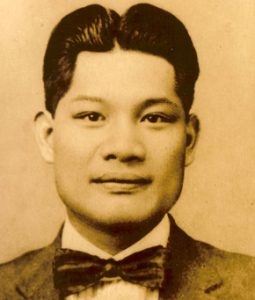Sen Yet Young
 The first Hawaiian resident to graduate from a flying school, and first to hold sea and land plane ratings, was Sen Yet Young, Honolulu-born son of a wealthy Chinese. Young soloed at the Curtiss flying school in Buffalo, New York on October 2, 1916. His instructor was Phil Rader who claimed to have been in the first known aerial combat (in Mexico, late in 1913). Later, he remained to study airplane mechanics as well. Subsequently, a Buffalo newspaper reported the Hawaiian’s intention to purchase a Curtiss plane “and take it to the land of the hula-hula.”
The first Hawaiian resident to graduate from a flying school, and first to hold sea and land plane ratings, was Sen Yet Young, Honolulu-born son of a wealthy Chinese. Young soloed at the Curtiss flying school in Buffalo, New York on October 2, 1916. His instructor was Phil Rader who claimed to have been in the first known aerial combat (in Mexico, late in 1913). Later, he remained to study airplane mechanics as well. Subsequently, a Buffalo newspaper reported the Hawaiian’s intention to purchase a Curtiss plane “and take it to the land of the hula-hula.”
Few people knew why Young took flight training or how he intended using the rare skills. Y. Ahin, Young’s father, was a chose friend of Dr. Sun Yat-Sen, a fellow immigrant also living in Honolulu. Feeling he was China’s man of destiny, Sun founded a revolutionary confederation (1894), the Save China League (later renamed the Kuomintang), and developed techniques to overthrow the Manchu leaders. These were to consolidate anti-Manchu secretary groups, link in the modernized overseas Chinese, and instigate incidents which inspire rebellious actions; then effect a revolutionary administration. In preparation for the final blow, Sun spent much of his time soliciting support overseas. Often he stayed at the home of Y. Ahin in Honolulu. When only 11 years old Sen Yet Young listened to the revered Dr. Sun’s words and vowed to one day help his cause.
After a successful coup in 1911, Sun was sworn in as the first president of the Republic of China (January 1, 1912). But the statesman was deposed by imperial general Yuan Shih-K’ai. Dr. Sun attempted to overthrow the new government but failed and was forced to leave the mainland of China.
Sun began pre-revolutionary tactics once again. Young was now in a position to help. A certificate issued in China commemorating Sen Yet Young’s death reveals his activities:
“Following the death of Yuan Shih-K’ai, the Kuomintang had established itself as the controlling party of China with Dr. Sun Yat-Sen as its president. With the nationalist government under democratic principles, the party’s new push was for national unity which could only be brought about by the abolishment of warlordism. This, however, was a slow and enduring process since the Kuomintang had only light and limited armaments with which to fight the warlords as they had previously done against Yuan Shih-K’ai. Seeing the lack of effective weapons, one of the Kuomintang members stood out as a national patriot by devoting his life to the establishment of larger, more effective and more powerful military armaments, Young Sen Yet.”
“In the seventh year of the Republic of China and at the age of 27, Young designed and flew the first Chinese built airplane. Then in the eighth and ninth year, Young Sen Yet, with Chinese-built and foreign-built airplanes, helped the Nationalist government beat the warlords in the Kwantung province. Following that, he went abroad to do more studying on the rapidly advancing science of aviation. He went back to Hawaii, then Massachusetts, New York, Mexico, and Japan to study the different techniques of airplane building. During that entire trip, he campaigned for the Kuomintang and collected money from overseas Chinese to support the education of Chinese boys in aviation school. His own father, Y. Ahin, had contributed enough money to purchase four airplanes for China. Following that campaign, more than 10 Chinese pilots were successfully trained for aviation. Each of these men at a later date became a general of the air force in different provinces of China.”
The memorial to the flying Islander stands in the Chinese counterpart of Arlington National Cemetery, in Canton. His widow, Shing Du Shung, was on the Communist “most wanted list” and barely escaped with her life into Macao. She presently resides with their only son, Tim Oy Young, in the United States. The young man also learned to fly at a Curtiss School then flew with the Chinese against Japanese warplanes. In later years, he worked in Pearl Harbor. Sen Yet’s twin daughters reside in the freedom of Hawaii, as mainland China remains in torment. One, Mrs. Florence Wai-Kyiu Doo, managed to rescue the other, Canton-raised Mrs. Wai-See Young Lowe from behind the Bamboo Curtain in 1956.
Excerpted from the book Above the Pacific by Lieutenant Colonel William Joseph Horvat, 1966.
Related content
Chinese Aviation Day Honors Island Son Excerpt from the Honolulu Star Bulletin November 20, 1988.
Aviator Remembered: Young
Hawaiian Bird Man Earns His Pilot License
Photo Reference
Wai Doo, Leigh. (n.d) An Appeal to the Lafayettes among you. Sen Yet Young. https://senyetyoung.com/